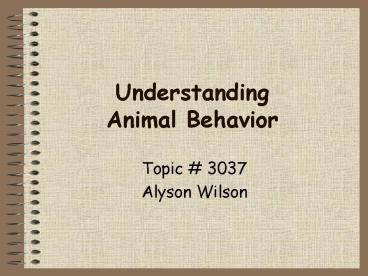Understanding Animal Behavior - PowerPoint PPT Presentation
1 / 23
Title:
Understanding Animal Behavior
Description:
Understanding Animal Behavior Topic # 3037 Alyson Wilson What is Behavior? Behavior is... According to Webster... a Conduct or Action In animals, the ... – PowerPoint PPT presentation
Number of Views:72
Avg rating:3.0/5.0
Title: Understanding Animal Behavior
1
Understanding Animal Behavior
- Topic 3037
- Alyson Wilson
2
What is Behavior?
3
Behavior is...
- According to Webster...
- a Conduct or Action
- In animals, the individual and group actions that
take place in order for them to live and function
in their environment - Ethology is the study of animal behavior
4
What is Anthropomorphism?
5
Anthropomorphism is
- Attributing human characteristics to animals
- Projecting human emotions onto animals (I.e. the
bull is mad, someone made him angry) - Note
- Need to make sure we record is what we observe
objectively - Interpret results later
6
Animal Behaviors
- Nest building (Sows)
- Mating Behavior
- Postpartum Behavior
- Environmental Comfort
- Social Behavior
7
Nest Building
- 3 Days prior to labor, sow spends majority of
time eating and sleeping - Sow will start nest building as labor gets closer
- Sow will try to clean and dry an area and will
chew long grass/straw to provide bedding
8
Nest Building Cont...
- Sow may change nest area more than once
- Pawing activities occur
- Sow may resist human intervention regarding nest
bedding - Time will vary with each sow but all will utilize
dry bedding material
9
Mating Behavior
- Threat Displays (Males)
- Bulls
- Arching of the neck
- Protrusion of eyeballs
- Erection of hair along their back
- Pawing the ground
- Turning of the shoulder toward threatened animal
10
Mating Behavior Cont...
- Threat Displays Cont
- Stallions
- Rearing on hind legs
- Laying back of ears Rams
- Rams
- Vigorous stamping of forefoot
- Nudging
11
Mating Behavior Cont...
- Estrus Behavior
- Cows
- Increased excitability
- Licking
- Mounting other females
- Ewes
- Difficult to see unless with a ram
- If ram present, will seek out his company and
stay with him
12
Mating Behavior Cont...
- Estrus Behavior Cont...
- Sows
- Pressure on sows back causes her to stand
- Sow becomes restless when enclosed
- Ears may be laid close to head, turned up and
backwards and held stiffly
13
Postpartum Behavior
- Mares
- Mare will often lie exhausted for 20-30 minutes
- Mares do not eat afterbirth, but will groom foals
14
Postpartum Behavior Cont...
- Cows
- Cow will lick her own urine discharge
- Cow will rest and then clean her calf
- Cow will usually eat the placenta
15
Postpartum Behavior Cont...
- Ewes and Does
- Ewes and Does eat entire afterbirth
- Recognition of ewe/lamb and doe/kid is very
important - Rejection may occur if young is taken away after
birth and returned later
16
Postpartum Behavior Cont...
- Ewes and Does Cont
- Critical time period can be as little as 1 hour
- Management practices
- Encouraging an orphaned lamb to be adopted
- Rubbing afterbirth on orphan
- Skinning a dead lamb (of foster ewe)
17
Postpartum Behavior Cont...
- Sows
- Sows pay little attention to young until last one
is born - Sows will eat part or all of afterbirth unless
removed - Sow will call litter to suck using short repeated
grunts
18
Postpartum Behavior Cont...
- Sows Cont
- Sow may emit barking grunts if disturbed by an
intruder - Sows rarely lick or groom young
- Sows may also crush their young with sudden
movements
19
Environmental Comfort
- Discomfort Behavior
- Feather picking and cannibalism in poultry
- Tail Biting and ear chewing in swine
- Too Cold
- Huddle together/pile up
20
Environmental Comfort Cont...
- Too Hot
- Cattle and sheep seek shady areas
- Pigs seek wet areas to lie in
21
Social Behavior
- Males fight unfamiliar males
- Cows, sows, and mares develop a pecking order and
fight less intensely - Ewes seldom fight
22
Social Behavior Cont...
- Social order in cow herds are influenced by
- age, size, strength, horns (if any), and
experience - Once social order is established in cow herd it
will remain the same for years - Pigs develop a social order at birth
23
Social Behavior Cont...
- Closely confined pigs have some difficulty
establishing a social order - Pecking order in chickens is found in feeding,
nesting and roosting - low-status birds get less feed and eat early in
the morning and later at dusk

